This article is based on the transcript of the talk I gave for the 2013 conference of the International Communal Studies Association. It has been adapted to improve readability and clarity. It is offered here as a compliment and supplement to the video of the talk.
1 – Introduction
Thank you. It’s a delight to be back here. Graham was talking about being moved. I’m very moved to just be standing here. Thank you, Graham, for inviting me to present to this ICSA conference. I’m very touched to be here.
I have something that I’m really excited to share with you. I need to warn you up front that it’s something with a number of different pieces to it. I want to be able to connect some dots but I’ve got to communicate what those dots are to begin with. I have the confidence that this is a high-capacity crowd, so I think we’ll be able to do all right with it.
I am cognizant that, for a number of people in the audience, English is not your first language, so I will try to speak in a way that will be intelligible. I also have more text in the slides than I might have if I were just speaking to a group of fellow Americans. For those of you who are into the fine points of how to do presentations, understand that the reason that I have more text is for the sake of those who don’t have English as a first language. And then the other reason is that it helps me remember what it was that I meant to say.
I’d like to start off with a little preview, which is to say —

This is the summation of the talk, that I’ve never been more encouraged about the future than I am today. I hope that by the end of this talk, you’ll understand why I’m feeling this way.
Okay, let’s get into it. The major focus of this talk is going to be looking at where we are in history. What is it that’s going on right now? What’s the momentum of the times? Where have we come from? Of course for this conference, a particular emphasis will be on the implications for intentional communities.
2 – System domains
But before even getting into that, I’d like to start with a piece that deals with a certain characteristic of systems that I haven’t found a lot of literature about, but I’ve increasingly felt is one of those really important things to understand about systems. I’m describing this as system domains. So what is a system domain? A system domain is something that grows out of the relationship between a system and its context. I’m going to give you a verbal description but then I’m going to give you a bunch of examples, and this is most easily understood through the examples. So don’t worry too much about understanding this verbal description. A system domain is a region in the relationship between a system and its context, where the system has a characteristic set of behaviors. Additionally, the behavior of the system can change dramatically when you move from one domain to another domain.
2.1 – H2O
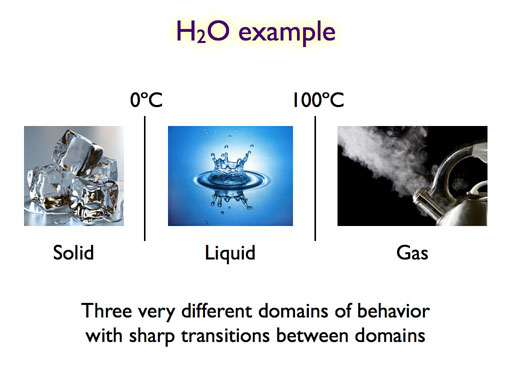
For our first example, let’s look at H2O, which we’re most familiar with as a liquid. But if you get the temperature above boiling, of course it becomes a gas. And the behavior of a liquid and the behavior of a gas are quite different. Go down below freezing and it becomes a solid. Again a very different set of behaviors. Anywhere from just above freezing to just below boiling, it’s a liquid. It has a similar set of properties in all that territory, yet when you cross a very narrow transition, it moves into a very different set of properties. Note the sharp transition between those domains.
2.2 – Home Heating
The next example is going to be something most of us experience — home heating. There’s a house. Sometimes it’s warm and sunny. Sometimes it’s stormy and cold.
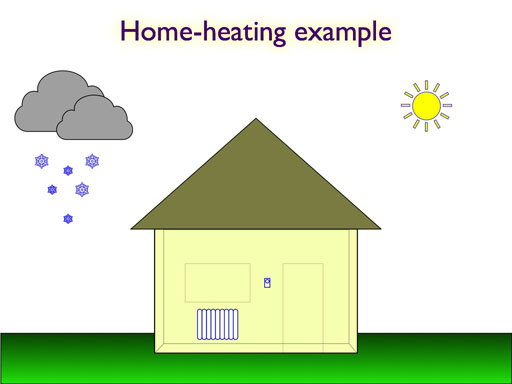
And because of that and because we like to have a more uniform experience for ourselves, we put in heating systems. So the house has got a little thermostat here and a little heater. We’re going to treat the house and the thermostat and the heater as the system, and the inside temperature is going to be the key characteristic that we’ll track. We’re going to treat the outside weather and the outside temperature as the context, and we’ll consider the relationship between the system’s inside temperature and its context in terms of outside temperature.
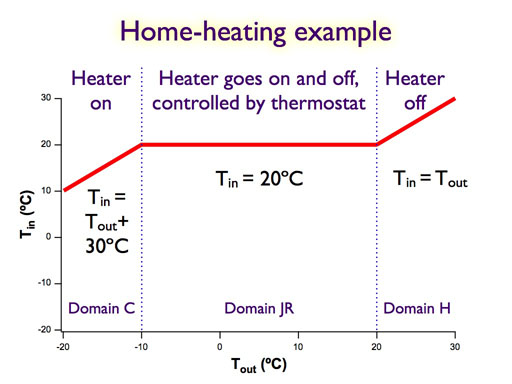
Over a wide span of outside temperature, hopefully the inside temperature stays constant. That’s after all why we have the heating system. But if the outside temperature goes above where the thermostat is set, then the inside temperatures is going to go up also. And if it gets get cold enough, you’ll get to a point where your heating system is going full time and yet it’s still not keeping up, so the temperature inside the house will go down as the outside temperature goes down.
Each behavior can be described by a simple formula but we need three different formulas. So we’ve got three different domains. In the center, which I’m calling domain JR for ‘just right’ (this is a sort of Goldilocks story), the heater goes on and off and the temperature stays constant. That’s the set of behaviors in that center domain. Up in domain H for ‘hot,’ the heater is off and the temperature goes up. And then down in domain C for ‘cold,’ the heater is on but it’s not able to keep the temperature from dropping. So we have three separate domains in which the description of the behavior stays the same within the domain but between domains it changes dramatically.
2.3 – Ecosystem
The third example is an ecosystem. We’re going to look at a forest. The context will be the resources that the forest draws on. And we’re going to start with bare ground and watch how the forest develops over time. We’re going to start with something like this.

And we will wind up with something that looks like this old-growth forest.

That’s the Hoh River rainforest out in my part of the world, by the way.
If we look at how the total biomass develops over time, we’ll find that we get a curve that initially shows accelerated growth. But if we keep watching it, the curve decelerates and changes its shape. The overall curve is something that’s called an S-curve.

It’s a very common curve to show up in biological systems or any system in which you have some kind of reproductive growth that depends upon resources. The reason that the curve is turning over is because there’s something known as the carrying capacity, a certain limit that you can’t grow too much beyond.
I do want to acknowledge, however, that a lot of times you actually can overshoot the carrying capacity and, depending on what happens with the overshoot, you go into either a deep collapse or some kind of an oscillation.

But the S-curve (which is similar to the first half of the overshoot curve) will serve our purposes for now, because I’d like to focus on the midpoint of the S-curve. Below the midpoint, the ecosystem’s growth is reproduction limited. That is, the ecosystem is growing as fast as the various species can reproduce because there are lots of resources for the number of plants that are available. Once you get above that midpoint, it’s resource limited. So we’ve got two domains, but here the transition between them is much more gradual than in the previous examples.
You wind up with two different sets of species predominating in these two different domains. In the reproduction-limited domain, you get what are called pioneer species, and in the resource-limited domain, you get succession species. And this distinction between pioneer species and succession species serves as a wonderful analogy for understanding a number of things that are going on in human society at this point.
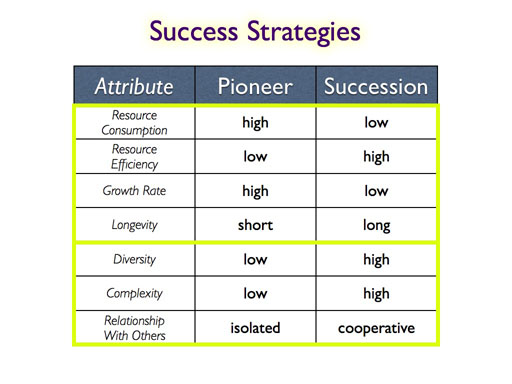
I’d like to point to the success strategies of the two different groups — the pioneers and the succession species. They’re mirror images of each other. I’m not going to go down this whole list. I’ll just say that the top four are pretty obvious in terms of what you would get if the distinction between pioneer and succession depends upon how many resources you have. But the bottom group isn’t quite so intuitively obvious. I want to point particularly to the attributes for succession species. They have high diversity; there are a lot of different succession species. The individual species tend to be relatively complex. And their relationship with each other is cooperative; there is a lot of symbiosis that goes on within succession species.
To summarize about system domains: They are created by the relationship between the system and its context. Sometimes it’s because the system is changing; sometimes it’s because the context is changing. The transitions between the domains can be either sharp or gradual: sharp like water was or gradual like the ecosystem was. System behavior changes across the transition.
If we know only one domain, we can be misled into thinking we understand the system. A great example of this is what happened with Newtonian physicists around 1900 when quantum mechanics and special relativity start coming in, and the Newtonian physicists said, “Hey wait a minute. We understand the world. It’s all Newtonian.” Well, the problem was that the domain that Newtonian physics works in has to have speeds that are slower than the speed of light and distances that are large compared to atoms. When you’re dealing in that domain, Newtonian physics still works really well.
We as humans get caught up all the time in discovering a certain domain of understanding. We extrapolate that it is the total understanding and then we get really shocked when we discover the edge of the domain. So because of this, identifying a system’s domains and transitions is critical to fully understanding the system.
We’re going to take these ideas about system domains and apply them to the ‘system’ of human culture as it evolves through history.
3 – Where are we in history?
I’d like to start this look at history with a brief look at the last century or so and then step back further to look at the last 16,000 years. Finally, grounded in that sense of deep human history, we’ll move forward to look at the 21st century and where things are headed.
3.1 – 1900 to now
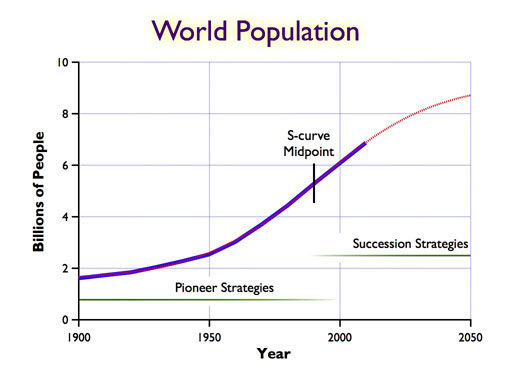 I want to focus on world population. Population is a wonderful aggregate indicator for what’s happening to the average person and not just the people who show up in history books. From 1900 to 2010, the population grew by 4.2 times — a huge increase in population in the last century or so. However, if we do a little curve fitting, we will find an S-curve that fits the data quite well. It’s not exponential growth. It only looks exponential at the beginning. The midpoint on the S-curve comes at about 1990. We’re a little over 20 years past the midpoint. If we make the analogy with the pioneer and succession species, then indeed up until 1990 or so, pioneer-type strategies should’ve been the thing that the context was supporting. But we’ve now moved into a new domain, yet because we’re humans, we don’t realize it yet. Going forward, it will be the succession-species strategies that will have the support of the context that we’re in.
I want to focus on world population. Population is a wonderful aggregate indicator for what’s happening to the average person and not just the people who show up in history books. From 1900 to 2010, the population grew by 4.2 times — a huge increase in population in the last century or so. However, if we do a little curve fitting, we will find an S-curve that fits the data quite well. It’s not exponential growth. It only looks exponential at the beginning. The midpoint on the S-curve comes at about 1990. We’re a little over 20 years past the midpoint. If we make the analogy with the pioneer and succession species, then indeed up until 1990 or so, pioneer-type strategies should’ve been the thing that the context was supporting. But we’ve now moved into a new domain, yet because we’re humans, we don’t realize it yet. Going forward, it will be the succession-species strategies that will have the support of the context that we’re in.
Someone might object and say, “Oh yeah, curve fitting, easy, but what is there around us that suggests that we really have moved from a time that wasn’t resource constrained into a time that is resource constrained?”
One of my favorite indicators of what’s going on for that issue is the global ecological footprint. How many of you are familiar with the ecological footprint? I see some hands going up, others not. Let me just say that it is a measure of how much human activity is filling the bio-capacity, the ecological capacity of the planet.

I would point out that more than half of humanity’s current ecological footprint is from CO2 from fossil fuels. We’re now at a point where we’re using one and a half Earths. You could say, “How in the heck could we be using one and a half Earths?” The ecological footprint is a measure of what the sustainability requirements are. We’re over our sustainability requirements. We’re effectively over our carrying capacity, but the atmosphere is absorbing the CO2 and the effects won’t come through for a while, so that’s how we can do it.
There’s nothing hard-fixed about saying that a certain population must have this kind of footprint. If we were getting our energy from renewable energy sources for instance, not from burning fossil fuels, then the CO2 part of the footprint would go away. If we were being more efficient in the way we were using land for getting food, fiber and timber, then that part of the footprint would be smaller. So this isn’t a strict hard sentence. We actually have a fair bit of choice in the ratio between human population size and global ecological footprint. But this graph reflects business as usual. It reflects how we’re currently functioning.
This is an example of — an indicator of — what I would more broadly describe as the limits-to-growth crisis, which comes out of the fact that we’re dependent on a number of resources that are themselves finite in one way or another. There are nonrenewable resources (fossil fuels and others); renewable resources that have maximum sustainable yields, like fisheries where we’re overfishing; and natural waste processing services, such as the estuaries that clean up water and the planet’s ability to absorb carbon dioxide. In all these cases, we’ve overshot but time-lags are delaying the full impact. This is a huge crisis that we all will need to deal with, one way or another.
I also want to say that, as far as I’m concerned, the issues here are not primarily technological. I like to say, “There are no environmental problems. There are only environmental symptoms of human problems.” This doesn’t reflect what we could do. This reflects the choices that have been made.
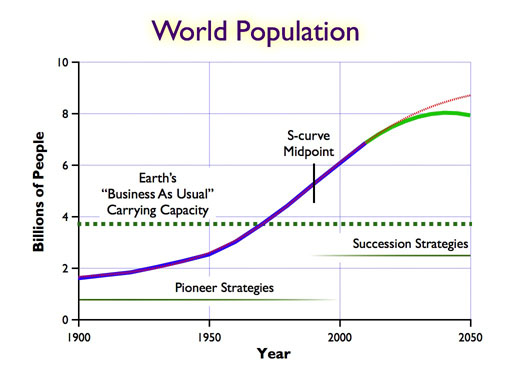
Pulling this back together, the chart now shows the carrying capacity which we crossed in 1970 when we had a population that was a little bit below 4 billion. And because it sure looks like we’re in overshoot, we could use a more realistic estimate of where the world population is going rather than just a simple S-curve fit. The curve that I’ve added is taken from Jorgen Randers in his book “2052.” Jorgen Randers was one of the three authors of the original limits-to-growth study in 1972. His curve peaks in 2040 at a population of about 8.1 billion. We’re currently about 1 billion away from that peak.
I want to point out how different it will be to be in a time when we’re not only at the peak but, before long, heading down, compared with the 20th-century experience of such explosive growth. This will have huge impacts on all kinds of different things, number one being the economy, because we’ve built an economic system that presumes unending growth and when you don’t have unending growth, things change.
3.2 – Past 16,000+ years
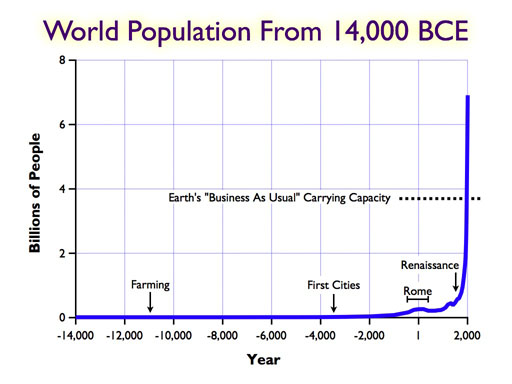
Again I want to look at population. By the way, historical dating has all sorts of interesting conventions. BCE is Before Current Era. It’s the same thing as BC, for those of you who are more familiar with that. I’ve used minus signs on the chart for BCE dates because frankly it’s easier to plot that way. There’s a 1 where AD meets BC instead of a zero because apparently there is no year zero: 1 AD and 1 BC are consecutive.
I want to show you data that the U.S. Census gathered, the best estimates for human population over this timeframe. That’s what the population curve looks like. It’s kind of interesting. To give you some points of reference I’ve indicated where farming starts, the first cities, where Rome was at its height, the Renaissance and the “business as usual” carrying capacity.
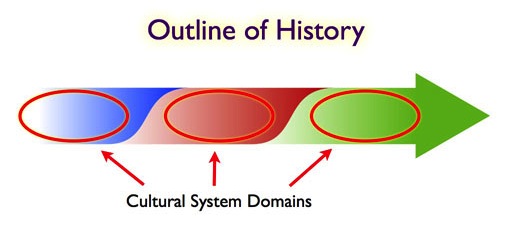
I’ve worked with this over many years in terms of what I like to describe as an outline of history, in which there are three cultural system domains. This is why I had to introduce the system domains to you, so that we could look at history in terms of these domains, with two cultural system transitions between them.
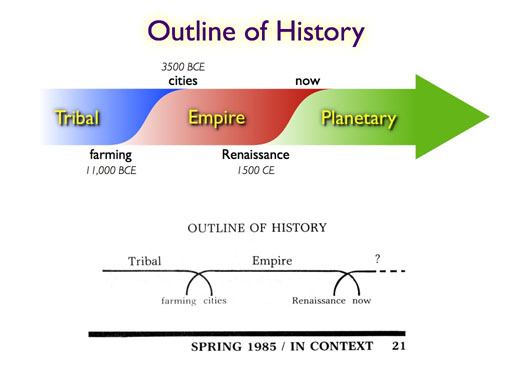
I describe the three domains as Tribal, Empire and Planetary. Some people use different terms but that’s what we’ll use in this talk anyway.
The first transition starts with farming and ends with cities. The second transition starts with the Renaissance and it probably hasn’t ended yet. We’re still in it. I can’t tell you how much longer this transition will last but I think we’re more than halfway through. And I think the next 20 to 40 years are going to be hugely consequential in terms of how this second great transition plays itself out.
This outline of history is something I’ve been playing with for a while. I went back and dug out the first time that I published a chart of this kind (in 1985) and you can see that was back before I decided to call the third era Planetary.
But this overall outline isn’t what I grew up with. I grew up with the sense that there was history, which began when writing began, and before that was something called prehistory. That’s what I learned in school and my sense is that that’s actually what most people in the mainstream carry around in their heads: that what’s happening now is all just part of one continuous flow of history.
Of course, especially here at Findhorn, I want to acknowledge that there have also been people who have said that we are at a significant turning point and in one way or another have described that we’re moving into some sort of new age. Joanna Macy’s ‘Great Turning’ is an example of focusing on this point.
Historians have also looked at this. I want to draw on the work of David Christian in his book “Introduction To Big History,”
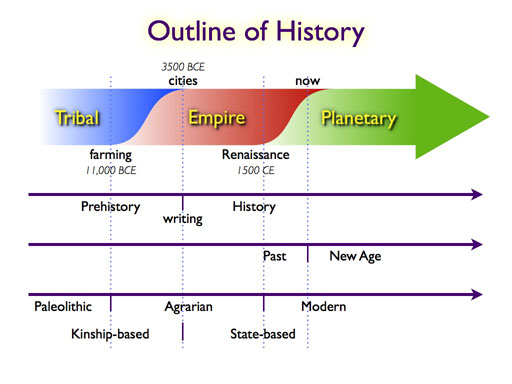
where he breaks up this timeline in terms of Paleolithic, Agrarian and Modern. However, he also says that break-up isn’t sufficient. he adds a second dimension in terms of kinship-based and state-based. So he has a split Agrarian.
If you put vertical lines in, you’ll see that this upper outline of history lines up pretty nicely with all the other breakpoints. And it’s not just because of what I’ve chosen here. I would say that these breakpoints of farming, cities, Renaissance and wherever we are now are pretty common breakpoints when people are trying to get a big overview of history.
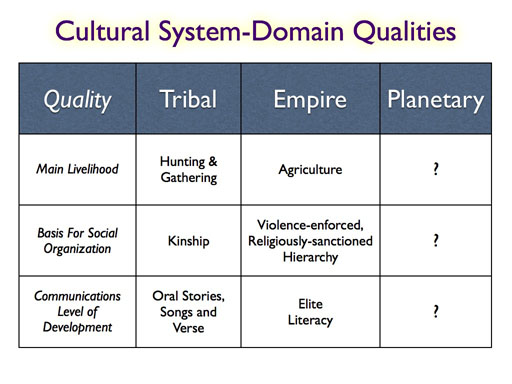
We’re going to focus in on three characteristics. Remember when we were looking at home heating, we just had temperature? Well, this is a little more complicated because it’s culture. There are many additional characteristics we could look at, but these three will do a good job of distinguishing the three eras.
We’re going to look at main livelihood, the basis for social organization and the communications level-of-development, which I would also call the communications state-of-the-art. In the Tribal Era, the main livelihood is hunting and gathering, the basis for social organization is kinship and the communications level-of-development is orality — stories, song, verse, etc.. And those characteristics are consistent throughout the Tribal Era.
In the Empire Era, the main livelihood is agriculture and the basis for social organization is violence-enforced, religiously-sanctioned hierarchy. Some of you may not like my expressing it that way, but for me that’s just the bald truth. Then the communications level-of-development was elite literacy.
In the Planetary Era, well, we don’t know yet. That’s the whole point. We’re trying to sort out what those characteristics might be like in the Planetary Era.
How are we going to do that? How shall we discern the future? First of all, we need to recognize that humanity doesn’t have a terribly good track record in terms of being able to discern the future. So we need to approach this first with a certain amount of humility and second with a willingness to take a fresh approach to trying to discern the future.
It’s hard to imagine beyond your own domain. Think, for example, if you are part of a hunting and gathering band back 20,000 years ago and you had this thought that came into your mind of cities and writing and all of that.
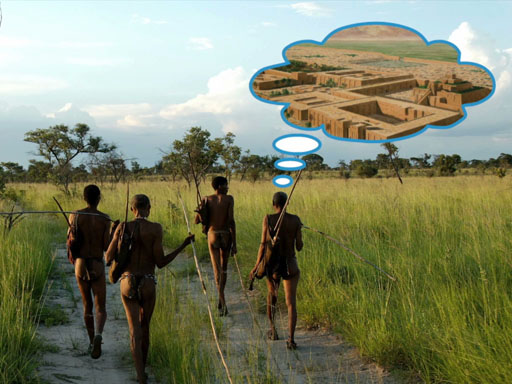
It would be very hard for you to understand those things. It’s just totally out of your experience. In the same way, think of somebody in 1500 — you might recognize her —

trying to understand what our life is like today. It would just be bizarre. As we try to think about what may be coming, we need to do it with a recognition that it’s a challenge.
So we need some kind of strategy that’s going to help us look across the Empire-to-Planetary transition. The strategy that I will be using and sharing with you is to, first of all, look for analogies in nature. That’s where the pioneer and succession species come in. We’ll also explore deep history from the perspective of cultural system domains, in search of essential patterns that transcend any one domain. Part of our problem here in trying to do this is that we are so immersed in the mentality of the Empire Era that we don’t see it. It’s the water we swim in. And so we’ve got to find a way to step out of that water far enough to be able to look into our potential future.
We’re going to proceed by starting with the first great transition. Then we’ll look a little bit at the Empire Era. Out of this, hopefully, we’ll get a sense of how to approach our current transition. And then, what we can learn from our current transition, hopefully, will give us a sense of where we’re headed in the Planetary Era.
3.2.1 – Tribal-to-Empire transition
What’s going on as we move from Tribal to Empire? Let’s start with focusing on the change of main livelihood, from hunting and gathering to agriculture.
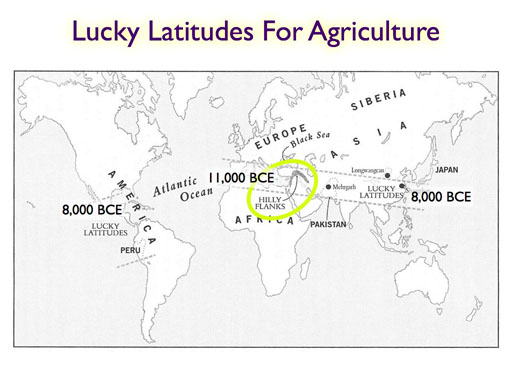
This happened in what gets described as the Lucky Latitudes. It happens first in the area of the Middle East that’s called the Hilly Flanks. It happened around 11,000 BCE there and then later happened in China — what’s now China — and in Middle America around 8000 BCE.
Why agriculture? Why did it appear there? What’s going on? It seems as though the key trigger was climate change coming out of the last Ice Age.
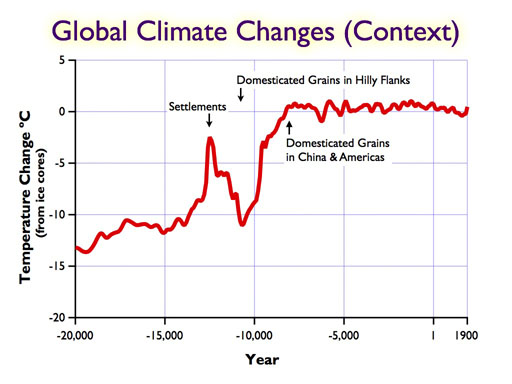
This chart is from ice cores, sort of a proxy for changes in global temperature. And you see the spike that comes up and goes back down again? There was a lot of local variation in the depth of the dip, nevertheless, there definitely was a dip, which is known as the Younger Dryas, or the Big Freeze.
What shows up in the archeological record is that at this spike, we start seeing lots of settlements. In most of the Tribal Era, people lived in a nomadic way. Especially during the Ice Age, things were not that abundant and you had to keep moving. Well, this peak as things warm up is sometimes described as the Golden Age of hunting and gathering, when there was such an abundance relative to the human population that people were actually able to stay in settlements. And some of the ones who stayed in settlements started actively cultivating some of the local wild food sources.
When the temperatures started going down again, most groups just went nomadic again, but in the Hilly Flanks area, their cultivation of wild grains had gone on long enough to breed them into higher-yielding domesticate varieties. You start seeing, in the archaeological record, domesticated grains down in the dip of that little bit of repeat of the cold period. It wasn’t until things warmed up again that you get the grains in China and the Americas, where conditions were not quite as favorable for domestication as they were in the Hilly Flanks. So in this sense, we have a change within the human cultural system that’s driven by the outside influence (the context) of the end of the Ice Age.
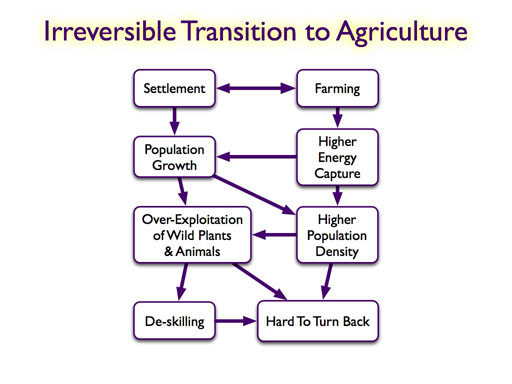
But once it gets going, it sets off a really powerful dynamic. Settlements and farming go very much together. They encourage each other. They depend on each other. Once you get that started, farming actually allows you to capture more energy per person and per area, per hectare. That, combined with the characteristics of settlements — the fact that the women who are going to be bearing children aren’t walking all the time — leads to population growth, quite significant population growth. These together allow not only population growth but higher population density. That’s what happens in a settlement. Well, with a higher population density and higher population, you overexploit all the animals and gather-able plants around you. So you become more and more dependent upon what you actually domesticated. In that process, you lose the skills that are required for hunting and gathering. And all of this — the overexploitation, the de-skilling and the higher population density — mean that once you got past a certain threshold of population growth, you really can’t turn back to hunting and gathering. It is an irreversible transition.
Now let’s look at the basis for social organization, moving from kinship to the violence-enforced, religiously-sanctioned hierarchy. Here I’m going to draw on the work of Ian Morris, another historian, particularly his social development index and the components for that.
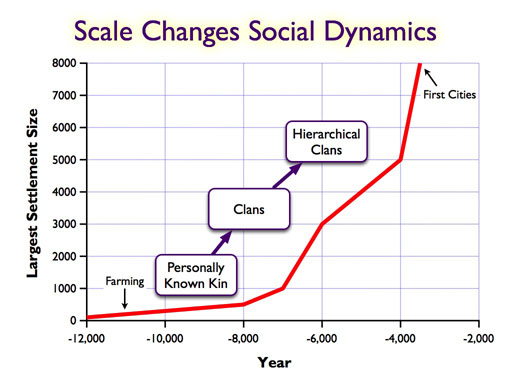
This is out of his work — a look at the size of the largest settlements as we move along in time. This is going from 12,000 BCE to 2000 BCE, or from the start of farming up to the first cities. When we’re close to the start of farming, especially with settlements that are below 500 and even below 1000, you’re in a range were the brain is able to really know the other people in the settlement. You can know them in a way in which you have a personal sense of them, and because of the history, it’s very much a kinship-based knowing.
Once you start getting larger settlements, you can’t personally know the 2000 or 3000 people in the same kind of way and so things morph. The kinship system morphs into something that’s much more dependent on clans and knowing people through clans. What the archaeological record shows is that as you move up in size, the clans begin to differentiate themselves and they become more hierarchical in terms of what goes in the burials and other things of this sort.
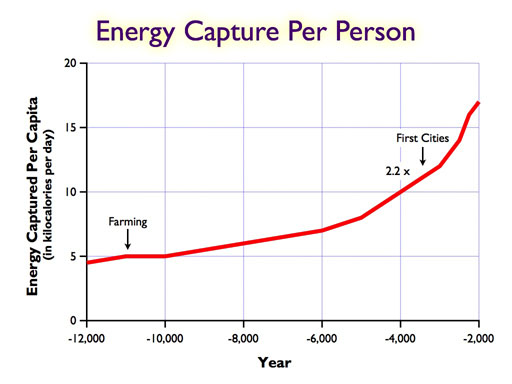
There’s also an important dynamic that comes out of energy capture. This chart shows how much energy is being captured per person. It gradually increases between farming and the first cities. At the first cities, it’s 2.2 times what it was at the start of farming. So that’s actually a big increase in the amount of useful energy — the kilocalories per day that you’re gathering per person — and it opens up all kinds of fresh opportunities.

When you have more energy per person, it allows more division of labor, because not everybody has to be working all the time on gathering food. You also create a situation with farming where you get a storable and steal-able surplus, and this is hugely important. More storable and steal-able surplus mean you’ve got more motivation for raids. More division of labor and more motivation for raids means you get better weapons and fighters. And that all shows up in the archaeological record. You get more violent intergroup conflict and more militarization of the communities. As time goes on, you go from communities that initially have no fortifications to communities that eventually have lots of fortifications.
This all developed into the patterns of Empire Era hierarchy. There were lots of different ways that this manifested. I’m only listing a few here: adults over children, men over women, powerful men and women over others, humans over nature, mind and spirit over the body, sky gods over everything. This legacy is still very powerfully with us today.
Finally, let’s look at the transition to literacy. It begins with numbers actually, before there’s much in the way of real transcription of spoken language. A lot of the first writing focuses on accounting and record keeping. You had to have enough people close enough together to have enough scribes to make it worth it to write things down. If you were the only scribe in town, who would read your writing? So it emerges with the first cities. It’s really important for the development of the Empire Era because it’s the complement to military force. Before that, you could go out and raid, you could do protection rackets, but you couldn’t really manage the area that you had conquered. With writing, you now can manage it.
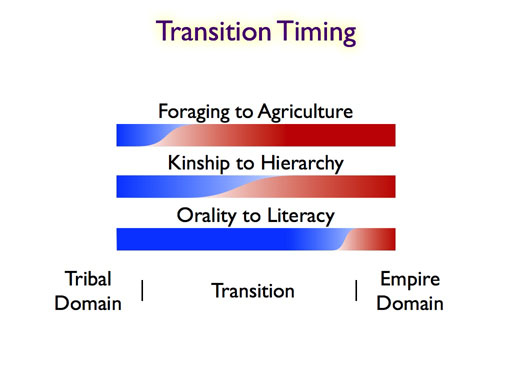
Within this big transition, there were a series of what you could call sub-transitions that spread out over time. Before, you’re in the Tribal domain. It’s pure Tribal characteristics. At the end, you’re in pure Empire characteristics, but in the middle, it’s a rolling transition.
So what lessons can we draw from this? First is that the driving forces were gradual and unobtrusive. Small changes could grow to irreversibility. Changes in one part of the system destabilized other parts. And it was powered by positive feedback loops that kept changing things until a new stable constellation of qualities was found. Also, the initial set of qualities — the foraging, kinship and orality — never go away. They just become secondary.
3.2.2 – Empire Era
Quickly, as I’ve been saying, the Empire Era characteristics are agriculture, hierarchy and literacy. I’ll just point out that 90% or more of the population were involved as peasants or serfs or slaves or whatever in agriculture, and literacy even in places like Athens apparently never got above 10 percent, so it really was an elite phenomena. These three characteristics stay stable for at least 4500 years. If you look at Egypt and you look at the Chinese Empires in 1500 and all the various different civilizations in between, they have the same group of patterns. Nevertheless, there were some changes over that 4500 years.
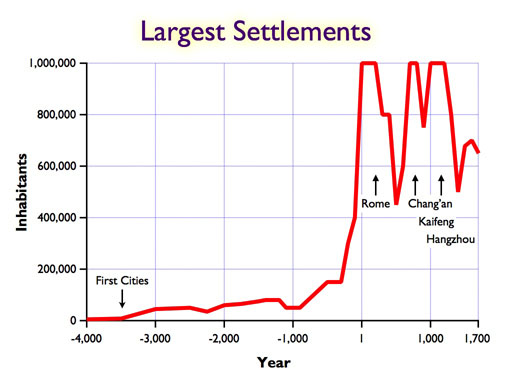
This is what happens with larger settlements. All those Roman engineers figured out how to do sewage and other things that enabled the settlement size to really grow. Then there were Chinese cities later that also grew up to about 1 million in population, but there seems to have been some kind of ceiling that was very hard for an agrarian civilization to go beyond.
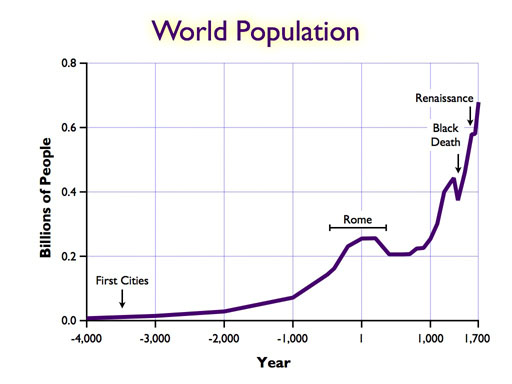
This chart shows population over that period of time. It kept growing as well. I like to think of population, and what I’m going to show you next, as being like raising the temperature of water. As you move up towards boiling, but short of boiling, water keeps the properties of a liquid even as it moves closer to the liquid-to-gas transition. I think of this population growth as raising the temperature (getting closer to a transition) while still staying within the Empire Era cultural system domain.
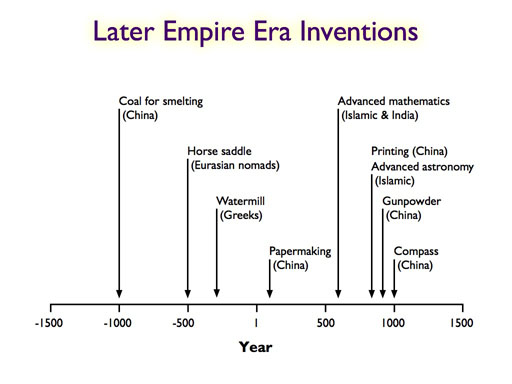
The other thing that ‘raised the temperature’ was that there were a number of really significant inventions that happened along the way. They didn’t coalesce well enough to change the pattern, but they laid the groundwork for the second great transition.
3.2.3 – Empire-to-Planetary transition
A key factor that to me sets off the second great transition or at least is a characteristic of it — and there is a lot of debate about why the transition started — is that innovation gets to be seen, at least in some ways, as an asset. That sets off a whole chain of activity that again creates a rolling transition. By innovation, I don’t just mean the technical stuff. Social innovations, economic innovations, anything that is a cultural change that lands. Of course, innovation has always been a factor in one way or another, but before the Empire Era, it was really just too slow to even notice, so people could maintain the mythology that they were always following tradition. During the Empire Era, elites were wary of innovation. They occasionally encouraged it a little bit then stomped on it, often pretty quickly. They were probably right. It was a threat to them. History has shown that it was a threat.
Europe wound up being best positioned to lead on innovation, just like the Hilly Flanks were best positioned for agriculture. There were multiple competing centers of power, so there wasn’t one central authority that could just stomp it all out. In 1500, Europe was relatively backward and they were just becoming aware that there were other places in the world more advanced than they were. So they knew that they had places to learn from.
They had a major initial success with warships.
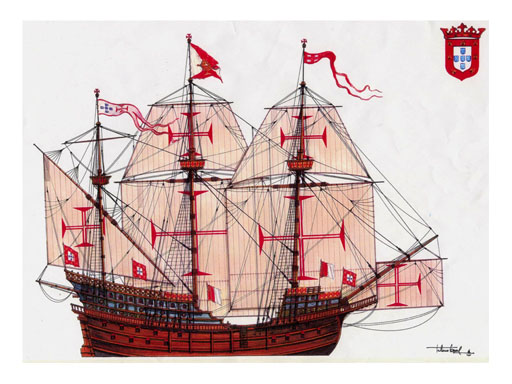
In 1500, this boat was the high-tech of the times, and it was what allowed a small, at that point culturally relatively backward, country like Portugal to establish a global empire. The problem was that it was a global empire based on technological superiority, which is a hard thing to keep because other people can copy you unless you keep moving.

So what’s the dynamic that happened? You had multiple centers of power and dependence on technological superiority. This led to a local arms race. The British wanted to their global empire and so did the Dutch. So did the French and the Spanish. So they got into battles with each other. That local arms race wound up accelerating Europe’s advantage because they moved each other forward in the process of that arms race. But it also cost the various kings quite a bit and they had to turn to the commercial sector and allow it more than had been allowed in the past. That was a dangerous thing (for the old elites) to do. All this emphasis on boats benefited commerce. So power started spreading to the commercial elites.
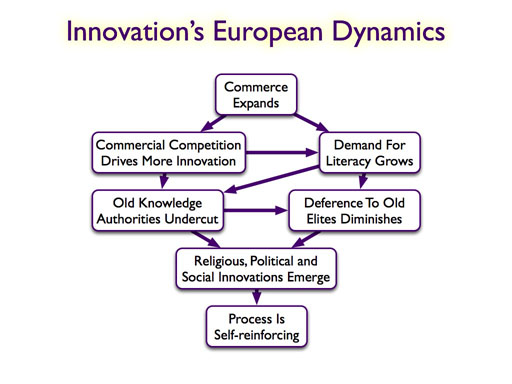
Commerce then expanded and as commerce expanded, it drove still more innovation. Demand for literacy grew. That undercut the old knowledge-authorities. Some of them didn’t like it — there was this thing called the Inquisition, you know — but it did wind up meaning that the deference to the old elites got diminished. Then you had all of the upheavals: the Reformation, the French Revolution, etc. all got driven in this atmosphere. It was a process that was, and still is, self reinforcing.
With dynamic innovation as an important factor, what can we now start to say about the transition for the three characteristics of livelihood, social organization and communications? If we treat the transition as an overlap between two eras, what can we say is showing up about the Planetary Era so far? We’ll start with main livelihood.
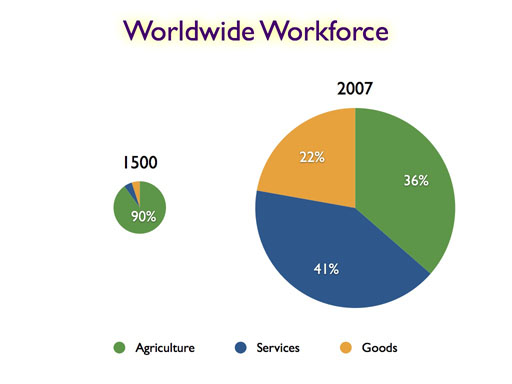
Here is the distribution of workforce in 1500, and the size of the circle is proportional to the world population at that point in time. Ninety percent of it is in agriculture. And here it is in 2007. The circle is much bigger, of course, because there are a lot more of us, but it’s also a much more diverse distribution. Agriculture is not even the largest of the pie slices. So we’ve moved to a time when there is no more main occupation. We have a huge diversity of occupations. I am going to suggest that in the Planetary Era, not only will we have diversity of occupations, but we will have diversity in a great many ways, just as succession species are characterized by a high level of diversity.
I’m going to jump down to communications next. In the past 500 years, the whole communications arena has changed enormously, especially in the last hundred years. It begins with travel, with all those boats and the way that opens up connections all over the world. Next, expansion of literacy, which began in Europe and is now at the point where the UN says that 84% of the world’s adults are literate to one degree or another. We passed the 50% literacy level somewhere around World War II, so it’s only been since then that more than half of the world is literate. It’s really quite recent from a cultural history point of view. Then there is the increase in the speed of communications: We all experience that today. Probably most people in this room can remember back to the point where you had fast telephone connections but a lot of other things moved a fair bit slower. Finally, we’ve move beyond just language. It’s multi-sense at this point, especially visual.
There’s been a huge increase in person-to-person access. I want to illustrate this with
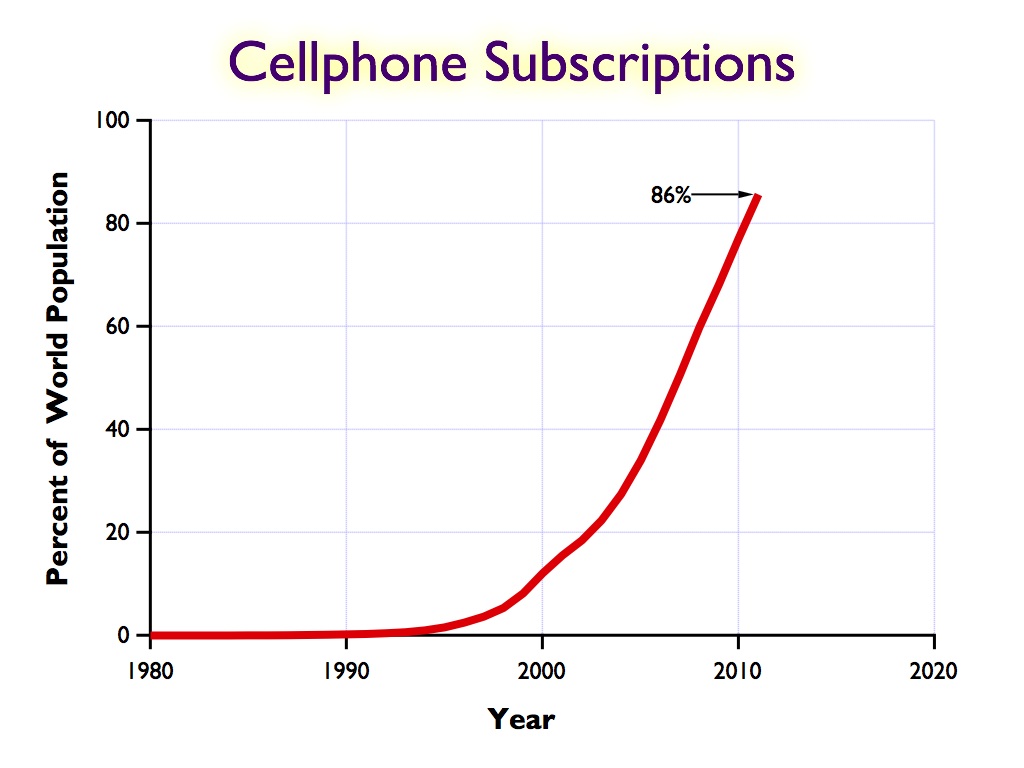
cell phone subscriptions. Here’s the curve of increase from 1990. This is a much smaller timeframe here than we were looking at [for population]– 1990, 2000 2010. You’re probably not at all surprised to see that the curve has shot up in this way, in that space of time, but look at the vertical scale. It is the percentage of world population, and in 2011 the number of cellphone subscriptions equalled 86% of the world population.
Now there’s a caveat that I have put in here. That doesn’t mean that 86% of the world’s population had cellphones, because of the way cellphone subscriptions get counted. But the World Bank says that in 2012, 75% of humanity had access to a cellphone either through a family member or a friend. Most of these cellphones are just what are called feature-phones — they’re relatively simple cellphones. However, 20% of humanity 15 years or older had smartphones at the beginning of this year. That’s a little over 1 billion people having smartphones. Another billion smartphones are expected to be sold this year, and for the first time they’re selling more smartphones than they are feature-phones. Now you may have your feelings about whether you like or don’t like smartphones, but from a cultural history point of view, putting that degree of communications access into the hands of so many people and allowing communication that is person-to-person rather than all done through broadcast is a huge system changer. From my point of view, just as the Empire Era needed literacy to come into full form, my sense is that the Planetary Era needs these new electronic tools — computers, internet, digital video and audio, smartphones, etc. — as well. That’s why the Planetary Era is still birthing.
Let me come back to the basis for social organization. I want to focus in on the way that over the last 500 years, more people have gotten more choice in their lives. It’s hard to think back to how little choice a peasant had in 1000 CE, but consider how much has changed in choice of: occupation, place of employment, political leaders, friends and associates, marriage partners, where to live, information sources, beliefs, goods and services, etc. Now I know not everybody in the world has that. The level of choice is not necessarily what it could be. I’m not saying this is perfect. What I’m saying is that these things have increased dramatically in the past 500 years. And I would also say that choice destroys the power of coercion. Coercion depends upon having people trapped, and if you have a meaningful choice, if you can vote with your feet, if you can simply walk away from the situation that would attempt to coerce you, then that coercion has a lot less power.
There have been two responses to this way in which there is now more choice. One of the responses has been a shift to indirect, covert, psychological methods of control. Let me step back and say that in the Empire Era, the elites were primarily military and religious and combinations of those two. We’re now in a time period when the Empire consciousness has moved into the commercial realm and the present elites are primarily commercial. They are more accustomed to using things like advertising and public relations. But this new approach to control is basically a system that doesn’t have integrity. It depends strongly on being able to control the flow of information, because if people get the total picture, it blows the game. So it’s actually a fairly vulnerable position for these elites to be in.
The other thing that’s happened in response to more and more choice has been the growth of all kinds of self-organizing consensual collaboration — everything from people choosing whom they are going to marry, to shared-interest groups that these days happen on all sorts of different scales, to businesses that form by people coming together with a shared intention, to communities like what you all are involved in and study. To me, this is analogous to nature’s approach to organizing complexity. In natural systems, you have co-evolution and symbiosis, co-evolution being a dance of collaboration. My sense is that, because this second response really is reflected in the way that nature deals with complexity and choice, it’s the one that has more staying power. So I’m going to say that what we’re seeing in the Planetary Era so far is a move towards self-organizing consensual collaboration as the basis for social organization. However, we’re still in the transition. I’m not saying that’s all there is.

I’d like to close this backward look in history with really taking in this population chart. I just love this chart; I think it tells us so much: it emphasizes that we are in a truly different world right now. With an ecologically full earth and communication so tight, we really have a small world — it is unlike the full gamut of that previous history in so many ways. And yet we think, “It’s just another century.”
3.3 – 21st century
Now let’s look forward and again ask, “How are we going to think about the future?” One thing I think we need to acknowledge is that the Empire Era is still very strong in our minds. It shapes our language and our beliefs. Almost all of them have their roots in the Empire Era, and that includes our ideas about human nature and simply how life works. And because we’re in a different world in terms of our daily life, but our minds are still in the past, this leads to all kinds of cognitive dissonance as we attempt to interpret what’s going on around us in the old terms. This leads to all sorts of frustrating misunderstandings — for all of us.
The other thing about the future is to know that there will be surprises. Truth is stranger than fiction. Some things will turn out better than we expect, some things worse. I like to say that it’s easy to see the disasters that are headed down the road. What we don’t see yet are the things that are yet to come up over the horizon, some of which will actually be beneficial. For example, it wouldn’t surprise me at all if, in the next 10 years, we got an invention like nanotechnology-based water desalination that made water desalination cheap enough that you could do it for agriculture. That would have a huge impact on where food could be grown and how much food could be grown. I just cite that as an example. We may have all kinds of positive things come up over the horizon, as well as the more challenging things. Of course, some things will just be totally unexpected.
I’d like to hope, though, that as long as we take these system domains and transitions into account, then at least the big picture, near-term, is potentially discernible. So that’s what I’m going to try to do next — to look at where we might be going with the Planetary Era.
In the process of stepping into that, I want to acknowledge that earlier in this talk I was emphasizing the big change that’s happened. We’ve moved into ‘full Earth’ and we’ve crossed over the carrying capacity. Yet as I was trying to discern what the characteristics of the Planetary Era had been so far, we looked back over the last 500 years. So does this moving into ‘full Earth’ invalidate what we’ve been seeing so far? I think not. I think actually the limits-to-growth crisis is going to simply enhance and accelerate the trends that we’ve seen so far.
It’s going to spur yet more innovation. Again I don’t mean just technologically. I think that the real constraints today are in social considerations. How people live and work with each other. The kinds of things that communities actually deal with best are the arenas where the broader society has the most significant constraints holding it back from completing the transition to the Planetary Era. And I certainly expect that successful innovations will use the succession species strategies. So that means there will be high levels of diversity, high levels of symbiosis, which I translate into human terms as self-organizing consensual collaboration.
Communications will be prioritized. I think one of the messages out of the high level of cellphone subscriptions is that people who don’t have running water and flush toilets nevertheless feel it’s important enough to be able to get communication access that they have prioritized it. I think that will continue to be the case. However, sustainability needs to be added as a fourth defining characteristic, because unless we manage sustainability, we’re still in a chaotic transition.
Particularly because of this need to transition to sustainability, and because we’re moving from this rapid population growth to something where we’re leveling off and then even going down, every facet of culture is likely to be affected in the near term — economics, governance, legal systems, healthcare, education, religion, warfare.
I especially want to comment on warfare and say that the long-term trends are that warfare is, in fact, winding down. My sense is that within two generations, we will have ended warfare as an institution, and when we end warfare as an institution, we will really know we have moved out of the Empire Era. I think we’re that close. If you think about the way in which warfare has been with us for 5000 years, another two generations is not that long. This is not a time to flag. This is a time to redouble the efforts to move through the transition. And it’s not simply because it’s morally the right thing to do. It also has huge system support. With our tight levels of both economic and communications integration and the need to become much more efficient, we will finally be able to acknowledge that warfare is enormously wasteful. It no longer is as economically valuable as it was in the Empire Era, and it will just lose its support. Right now, it really doesn’t even have the system support it used to and is running purely on the momentum from the past. My sense is that as new generations come along, they will not be convinced of its value.
That said, I also want to acknowledge that a lot of these changes are going to be resisted. After all — this is a sort of crude way to put it, but — the Empire Era was built on bullying. The bullies are not going to be enthused about losing their place and, of course, their mode of operation when they get stressed is to try to bully. As far as I’m concerned, I see this showing up in the behavior of all kinds of different fundamentalisms. To me, it’s not a matter of religious this or political that. It’s actually about people who have been raised in Empire Era traditions and feel those traditions are right. They draw on their interpretation of their religious traditions to justify why all of that Empire stuff needs to continue and they go for it. But they’re on the wrong side of history and the wrong side of the system support.
Nevertheless, agriculture, literacy and some level of command-and-control hierarchy are certainly not going away. I don’t see coerced command-and-control hierarchy continuing, but if there is a fire, I want the fire chief to be directing what the other people do, and they probably do too. These are just going to become secondary, the same way it worked in the previous transition.
3.3.1 – Planetary Era
Okay, now let’s look at the Planetary Era. As I see it at this point, the Planetary Era will be characterized by sustainability; diversity, not just in occupations but in lots of ways; self organization, which will seem chaotic to our minds but it’s the way nature does it; and connectivity, huge connectivity. One of the key things is that it will be at ease with innovation. It will be at ease with learning. It will not be afraid of discovering new things. And when we get to the point of being not afraid of discovering new things, then surprisingly enough we will have moved into a new stability. We will have moved into a new stable domain. Finally, human relationships at all scales will be fundamentally consensual.
So for me, the central issue of our times is not whether humanity or the Earth will survive. We very likely will. We could lose 90% of the human population and be back at the point that we were in about 1700. I’m not inviting that. I’m just pointing out that even a very great catastrophe would not eliminate humanity. Short of something like global nuclear war that destroyed most life on the planet, it would be very hard to completely kill off this widespread and highly adaptable species. We’ll likely find our way through this crisis and in so doing, complete the transition. I think that the limits-to-growth crisis is the final piece in the transition to the Planetary Era.
For me, the issue is how graceful can the transition be? How much suffering can be avoided? How much long-term damage can be prevented. So I’m not trying to say to you, “Hey, it’s all okay, you can go on vacation and it’s over.” No, this is the time to really redouble the effort because what we do over the next few decades will have a huge impact on how much suffering there is and how much long-term damage occurs.
I like to say we’re being called to be cultural midwives. There is a birth that is happening, and just as in a birth, you have a full spectrum from the possibility of a stillborn baby and a dead mother to something that is really beautiful and ecstatic. A good midwife can make a difference in terms of where you fall along that spectrum. So there’s a birth that’s underway and what we do will make a real difference in terms of how much suffering and how much long-term damage there is.
What we each do matters in that sense, and I want to acknowledge that it’s taken countless courageous choices by millions of people in hundreds of generations to get us to where we are at this point. And it’s going to take countless more. But if we’re aligned with those succession species strategies, we will have a path to success. And with today’s communications, learning and innovation processes have accelerated enormously, so that if we build good cultural DNA, we can spread it quickly.
So what do we need to do? First of all, we need to recognize that we are in this great transition and let go of the Empire Era. It’s still very strong in our minds. Find a way to honor it, bless it for its gifts, but let it go. And then step forward into the Planetary Era. In an ironic way, we need to be pioneers of what it means to be a succession species.
And we need to do it all with compassion. All of us are torn inside between what we grew up with and the reality that we have to deal with around us. And as we see others freaking out because they’re torn by those things, I think it’s important for us to approach them with compassion. To me that is the Planetary Era way to do it. If we see ourselves as fighting the Empire Era, then we’re still in the Empire Era. It’s only when we say, “It’s done” at some level and “I can meet you with compassion” that we really have stepped into the Planetary Era.
And then the action step is to innovate, implement and educate. What is going to drive this forward is all of the good social innovations that will come from places like the communities that you’re all involved with. And unless we work on those, we won’t change the system. If we’re focused backward on saying, “No, we don’t like this thing that’s going on” or “No, we don’t like that thing that’s going on,” then we won’t change the system. Bucky Fuller used to say that the only way that you change something is to make it obsolete. The only way that you make it obsolete is to come up with a better way of doing things, which is what innovation is all about.
So why am I so encouraged? I hope you get some sense of it by now. As I see it, the momentum of history is moving towards a cultural system domain that’s based on sustainability, diversity, self-organization and connectivity, and I’ll acknowledge that I like those things. I’m happy to be moving in that direction and I like the feeling of having the winds of history at my back as I do this. Even though we’re moving through turbulent times right now, the larger momentum is moving with us.
The obstacles we face are human, cultural and solvable. It’s not as if there were an asteroid approaching us and there was nothing we could do about it. This is all of our own making and of our own remaking. Even individuals and small groups can have a big impact through the innovate – implement – educate process if they’re aligned with Planetary Era qualities, because that’s what it takes to be successful as we move forward.
I see people all over the planet who are rising to the challenge and seizing the opportunity of this time. So it’s not as if it’s just the people in this room by any means. There are millions of people out there who are doing wonderful things that are moving us forward. All of that I find hugely encouraging.
4 – Implications for intentional communities
Now let’s look at implications for communities. We’re going to have many days to get into this part, so I’m going to be relatively brief. I want to acknowledge that the things I’m going to describe here are things that many communities have been doing for decades. I hope you will take this as an appreciative acknowledgment of the foresight of what those communities have been doing.
The first thing is that so many of the innovations that need to happen as cultural innovations are really best worked on in human-scale communities. So there’s a wonderful opportunity to build the cultural DNA that we really need. The communities that are innovative get to enjoy the benefits of living in this new culture sooner. As someone who both goes away from and comes back to a place like Findhorn, I can see the contrast with the broader society and I get the pleasure of experiencing the culture that’s here and being nourished by the culture that’s here.
These communities can also serve as sources of hope and experience — not just hope but grounded experience — for the wider world, by being centers of research, demonstration and training. I think that communities who are focused on creating their own private salvation, with the idea that the world is going to hell and they’re going to be the only safe places left, are in for trouble, frankly. I think that the communities who truly serve are the communities who see themselves as connected to the wider process and are willing to be the human research, demonstration and training points.
Related to this, here are my suggestions for communities:
— Examine your own images of the past and future. Look at places that you’re stuck in Empire Era thinking or in reaction to it, which is another form of being stuck in it.
— Expect the pace of change to be even greater than what we’ve had. For those of you who may not know hockey, there is a hockey expression that says, “Skate to where the puck will be.” The idea is to anticipate where things are going. Don’t just look backward and react to what has happened, but anticipate those changes, so that what you’re doing can meet them when you’re ready to get there. Work with the flow of history. Lead towards the emergence of Planetary Era by aligning yourself with those Planetary Era qualities.
— Innovate, implement and educate. If you have an inspiration for something that you feel would be a positive change, please go ahead and innovate with that. If you see some positive changes, some idea that somebody’s had or they’ve done a little bit of it, but you feel you could get it functioning better, you can do the development part. That’s what I mean by implement. And then once you’ve got something working well, get it out to a wider public. There’s something everybody can do along this innovate – implement – educate spectrum.
Thank you.
Robert Gilman, August 5, 2013
If you have questions or comments about anything in this article, please let me know.






